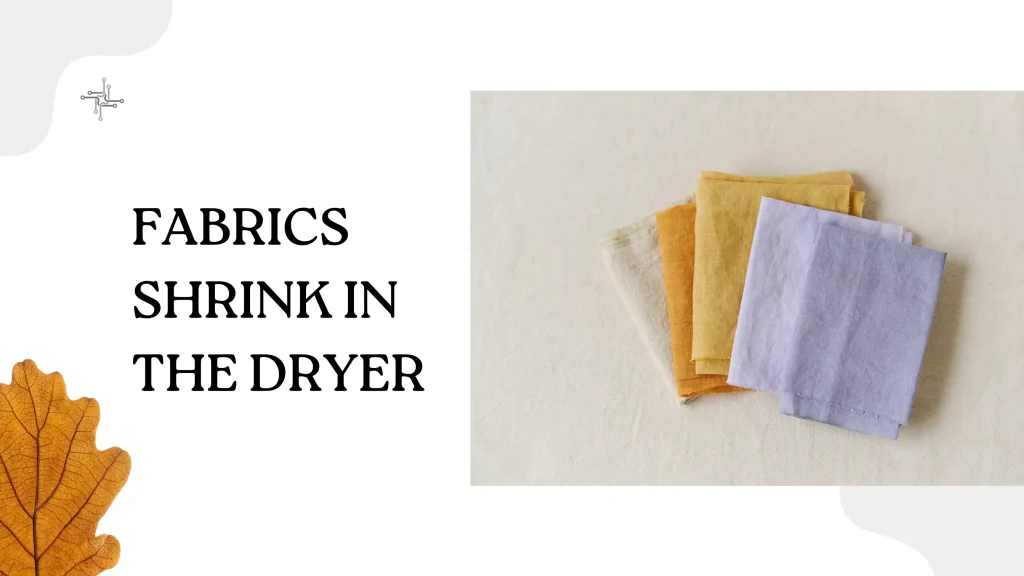Fabric shrinkage occurs when clothes reduce in size after washing or drying. It mainly happens due to heat, moisture, and agitation in the dryer. Natural fibers like cotton, wool, and linen are more prone to shrinkage compared to synthetic fabrics. The heat from the dryer causes these fibers to contract, leading to a smaller fit.
Knowing how shrinkage works helps you take better care of your clothes. By understanding which fabrics shrink, you can avoid mistakes like shrinking your favorite shirt. It also helps you choose the right drying methods for different fabrics. For example, air drying might be a better option for delicate materials.
Table of Contents
Fabrics That Are Most Likely to Shrink
Certain fabrics are more likely to shrink when exposed to heat in the dryer.
Cotton
Cotton is one of the most common fabrics that shrinks in the dryer. It’s a natural fiber, and when it’s exposed to heat and moisture, the fibers contract, leading to shrinkage. The more frequently cotton is washed and dried, the more likely it is to lose its shape and size. Pre-shrunk cotton garments may still shrink a little after multiple washes.
Wool
Wool is a delicate fabric that reacts to heat and agitation, causing it to shrink significantly. The fibers in wool are more sensitive to high temperatures and movement in the dryer, which leads to unwanted shrinkage. To avoid this, wool items should be air-dried, or dried on a very low heat setting to preserve their size and softness.
Linen
Linen is made from natural fibers and tends to shrink when exposed to high heat. Its fibers contract under pressure, especially when wet, causing it to shrink. It’s best to either air dry linen clothing or use the dryer on a low heat setting to avoid excessive shrinkage and maintain the fabric’s shape.
Silk
Silk is a delicate fabric made from natural fibers that can easily shrink when exposed to high heat. The fibers lose their structure and integrity when subjected to hot air in the dryer. To preserve silk items, it’s crucial to air dry them or use a low-heat setting in the dryer to avoid shrinking and potential damage.
How the Dryer Causes Shrinkage
The dryer plays a significant role in fabric shrinkage due to its heat, moisture, and agitation.
Heat and Moisture Impact
When clothes are exposed to high heat in the dryer, the moisture in the fabric evaporates. This causes the fibers, especially natural ones like cotton, to tighten and shrink. The heat opens up the fibers, and as they dry, they contract, causing the garment to lose size. The more moisture a fabric holds, the more it’s likely to shrink.
Mechanical Agitation
The tumbling motion of the dryer can also contribute to shrinkage. As clothes move around in the dryer, the fibers rub together, causing them to become more compact. This mechanical agitation can make natural fibers like wool and cotton shrink faster, as they are more sensitive to movement and heat. The longer clothes tumble in the dryer, the more likely they are to shrink.
Fabric Tension
When clothes are placed in the dryer, they often get stretched during washing or handling. The dryer’s heat and agitation can cause the fabric to relax, leading to shrinkage. For example, a shirt that is stretched out while wet might shrink back to its original size when dried. This tension release can result in a noticeable reduction in size, especially for fabrics like cotton and wool.
Factors That Affect Shrinkage
Shrinkage can vary depending on several factors, including the type of fabric, drying methods, and environmental conditions.
Temperature
Heat is one of the main causes of shrinkage. High temperatures in the washer or dryer can cause fibers to contract. Fabrics like cotton and wool are particularly sensitive to heat. Using high heat settings when drying can lead to more significant shrinkage, while lower heat or air drying can reduce the risk.
Fabric Type
Natural fibers like cotton, wool, linen, and silk are more prone to shrinking than synthetic fibers like polyester or nylon. Natural fibers absorb moisture and heat more easily, causing them to contract. Synthetic fabrics are generally more resistant to shrinkage because their fibers are less reactive to heat and moisture.
Drying Time
The amount of time a fabric spends in the dryer can impact how much it shrinks. The longer the exposure to heat, the more likely the fabric will shrink. Quick drying cycles or removing clothes before they’re fully dry can minimize shrinkage. Additionally, over-drying fabrics can cause them to shrink more.
Preventing Fabric Shrinkage in the Dryer
- Use Low Heat Settings: One of the most effective ways to prevent shrinkage is to dry clothes on low heat. High heat accelerates the shrinking process, especially for natural fibers like cotton, wool, and linen. Opting for a low or medium heat setting ensures that the fabric remains protected and reduces the chance of shrinkage.
- Air Dry When Possible: Air drying is a great option for delicate fabrics like wool, silk, and linen. Hanging or laying these garments flat to dry avoids exposure to the heat of the dryer, helping them maintain their original size and shape. If air drying isn’t an option, consider drying on a clothesline or using a drying rack indoors.
- Remove Clothes Early: To prevent over-drying, remove clothes from the dryer as soon as they are dry or just slightly damp. Over-drying fabrics can cause them to shrink further. By stopping the cycle early, you can reduce shrinkage, particularly for cotton and other natural fibers.
- Use Dryer Bags for Delicate Fabrics: For delicate or shrink-prone fabrics, using a mesh dryer bag can help protect them during the drying process. These bags prevent excess movement and friction, reducing the impact of mechanical agitation on the fabric. This is especially useful for items like sweaters and silk garments.
- Read Care Labels: Always check the care label on your clothes to see if the manufacturer recommends dryer use. Some fabrics are meant to be air-dried to avoid shrinkage. Following these instructions can help extend the life of your clothes and prevent unnecessary shrinkage.
What to Do if Your Fabric Shrinks
If your fabric has shrunk after being dried in the dryer, there are a few things you can try to restore it. First, you can soak the item in lukewarm water. After soaking, gently stretch the fabric back into shape. Lay it flat on a towel to air dry, or hang it up. This method works best for fabrics like cotton or wool, which can sometimes regain their original size when the fibers relax.
Another option is to use fabric softener. Wash the item again with fabric softener and gently stretch it while damp. Fabric softeners can help loosen fibers, making them more flexible and easier to reshape. However, this may not work for all fabrics, and heavily shrunk items might not return to their original size.
If these methods don’t work, you can consider taking the item to a professional cleaner. They may have specialized techniques to help restore the fabric or stretch it back to a wearable size. For valuable or delicate clothing, this may be the best option.
Conclusion
Fabrics shrink in the dryer is important for taking care of your clothes. Fabrics like cotton, wool, linen, and silk are more likely to shrink when exposed to heat. Knowing this helps you choose the right drying methods to prevent damage.
To avoid shrinkage, use low heat settings, air dry when possible, and always follow care labels. If your fabric does shrink, try gently reshaping it or using fabric softener. With these tips, you can keep your clothes in good shape and avoid unwanted shrinkage in the future.


